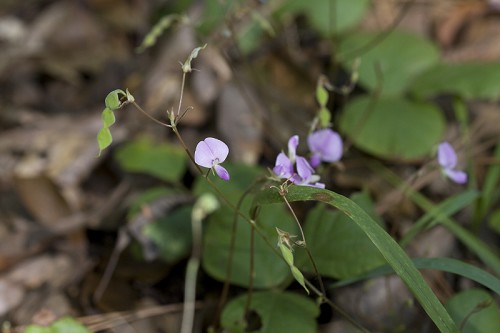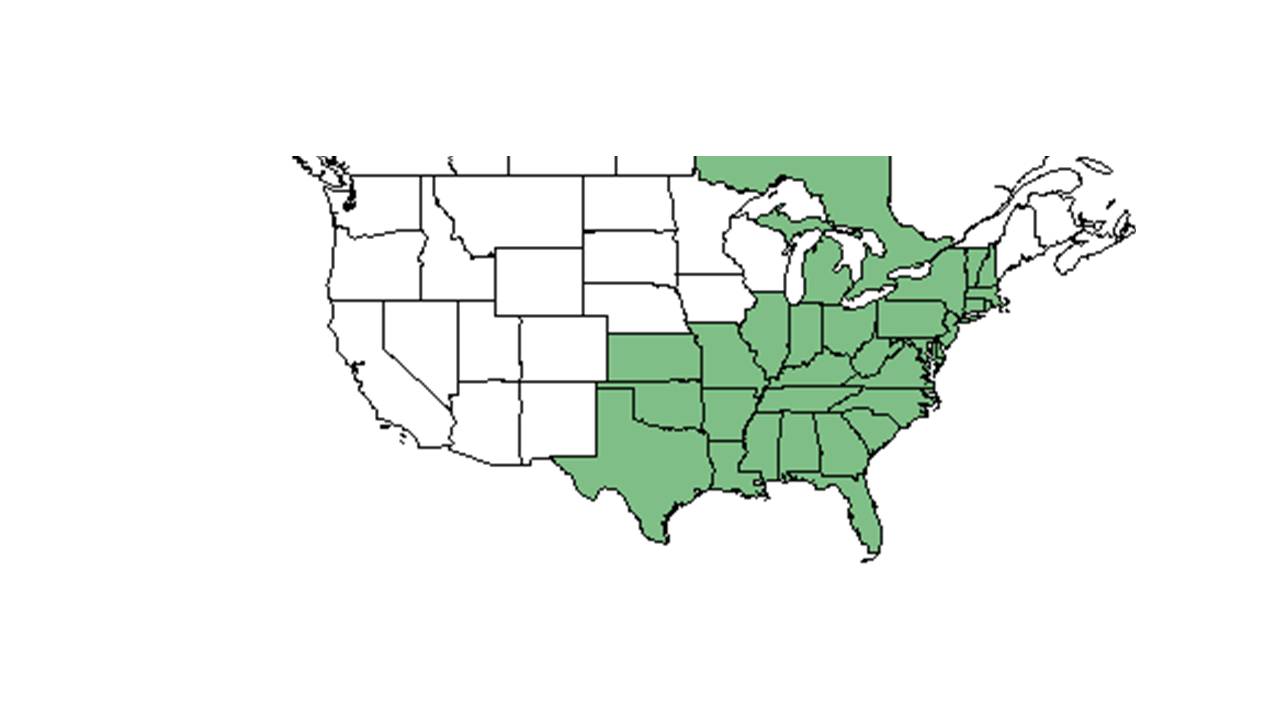Difference between revisions of "Desmodium rotundifolium"
(→Description) |
(→Ecology) |
||
| Line 33: | Line 33: | ||
==Ecology== | ==Ecology== | ||
===Habitat=== <!--Natural communities, human disturbed habitats, topography, hydrology, soils, light, fire regime requirements for removal of competition, etc.--> | ===Habitat=== <!--Natural communities, human disturbed habitats, topography, hydrology, soils, light, fire regime requirements for removal of competition, etc.--> | ||
| − | It is found in mixed hardwoods including pines, oaks, and hickories | + | It is found in mixed hardwoods including pines, oaks, and hickories. It is also found in lightly wooded hillsides, dry glacial drift, and open woods. It requires shaded areas. It is associated with drying sandy loam soil types.<ref name=fsu/> |
| − | Associated species include ''Desmodium lineatum, Desmodium ochroleucum, Rhynchosia difformis, Smilax pumila, Rhus aromatica'' | + | Associated species include ''Desmodium lineatum, Desmodium ochroleucum, Rhynchosia difformis, Smilax pumila, Rhus aromatica''.<ref name=fsu/> |
===Phenology=== <!--Timing off flowering, fruiting, seed dispersal, and environmental triggers. Cite PanFlora website if appropriate: http://www.gilnelson.com/PanFlora/ --> | ===Phenology=== <!--Timing off flowering, fruiting, seed dispersal, and environmental triggers. Cite PanFlora website if appropriate: http://www.gilnelson.com/PanFlora/ --> | ||
| − | It has been observed flowering from August through October and has been seen fruiting in September | + | It has been observed flowering from August through October and has been seen fruiting in September. <ref name=fsu/> |
| − | |||
<!--===Seed dispersal===--> | <!--===Seed dispersal===--> | ||
<!--===Seed bank and germination===--> | <!--===Seed bank and germination===--> | ||
===Fire ecology=== <!--Fire tolerance, fire dependence, adaptive fire responses--> | ===Fire ecology=== <!--Fire tolerance, fire dependence, adaptive fire responses--> | ||
| − | It becomes more robust in response to fire | + | It becomes more robust in response to fire.<ref name=fsu/> |
| − | |||
<!--===Pollination===--> | <!--===Pollination===--> | ||
<!--===Use by animals===--> <!--Herbivory, granivory, insect hosting, etc.--> | <!--===Use by animals===--> <!--Herbivory, granivory, insect hosting, etc.--> | ||
<!--===Diseases and parasites===--> | <!--===Diseases and parasites===--> | ||
| + | |||
==Conservation and Management== | ==Conservation and Management== | ||
==Cultivation and restoration== | ==Cultivation and restoration== | ||
Revision as of 13:04, 21 April 2016
| Desmodium rotundifolium | |
|---|---|

| |
| Photo by John R. Gwaltney, Southeastern Flora.com | |
| Scientific classification | |
| Kingdom: | Plantae |
| Division: | Magnoliophyta - Flowering plants |
| Class: | Magnoliopsida – Dicotyledons |
| Order: | Fabales |
| Family: | Fabaceae ⁄ Leguminosae |
| Genus: | Desmodium |
| Species: | D. rotundifolium |
| Binomial name | |
| Desmodium rotundifolium DC. | |

| |
| Natural range of Desmodium rotundifolium from USDA NRCS Plants Database. | |
Common name: Prostrate ticktrefoil
Contents
Taxonomic notes
Synonym: Meibomia michauxii Vail
Description
Flowers may be blue or light purple in northern states. [1] In southern areas, fresh corollas are rosy pink, then fading into a whitish color with age. [1] Creeping and trailing habit and prostrate.[1]
Generally, for Desmodium genus, they are "annual or perennial herbs, shrubs or small trees. Leaves 1-5 foliolate, pinnately 3-foliolate in ours or rarely the uppermost or lowermost 1-foliolate; leaflets entire, usually stipellate; stipules caduceus to persistent, ovate to subulate, foliaceous to setaceous, often striate. Inflorescence terminal and from the upper axils, paniculate or occasionally racemose; pedicel of each papilionaceous flower subtended by a secondary bract or bractlet, the cluster of 1-few flowers subtended by a primary bract. Calyx slightly to conspicuously 2-lipped, the upper lip scarcely bifid, the lower lip 3-dentate; petals pink, roseate, purple, bluish or white; stamens monadelphous or more commonly diadelphous and then 9 and 1. Legume a stipitate loment, the segments 2-many or rarely solitary, usually flattened and densely uncinated-pubescent, separating into 1-seeded, indehiscent segments." [2]
Specifically, for D. rotundifolium species, they are "perennial with trailing, densely villous or very rarely glabrate stems 0.5-1.5 m long. Terminal leaflets suborbicular to widely rhombic or obovate, 3-7 cm long, densely appressed to spreading pilose on both surfaces; stipules persistent, ovate, obliquely and widely clasping at base, 8-12 mm long; stipels usually persistent. Inflorescences typically axillary, occasionally terminal, racemose to paniculate; pedicels 6-13 mm long. Calyx sparsely pilose to puberulent; petals purple, 8-10 mm long; stamens diadelphous. Loment of (3) 4-6 segments, each 5-7 mm long, 4-5 broad, both sutures and sides densely uncinlate, both margins about equally indented; stipe 2.5-5 mm long, mostly included within calyx tube and exceeded by stamina remnants." [2]
Distribution
Ecology
Habitat
It is found in mixed hardwoods including pines, oaks, and hickories. It is also found in lightly wooded hillsides, dry glacial drift, and open woods. It requires shaded areas. It is associated with drying sandy loam soil types.[1]
Associated species include Desmodium lineatum, Desmodium ochroleucum, Rhynchosia difformis, Smilax pumila, Rhus aromatica.[1]
Phenology
It has been observed flowering from August through October and has been seen fruiting in September. [1]
Fire ecology
It becomes more robust in response to fire.[1]
Conservation and Management
Cultivation and restoration
Photo Gallery
References and notes
- ↑ 1.0 1.1 1.2 1.3 1.4 1.5 1.6 Florida State University Robert K. Godfrey Herbarium database. URL: http://herbarium.bio.fsu.edu. Last accessed: June 2014. Collectors: L. C. Anderson, Wilson Baker, Patricia Elliot, H. Roth, V Craig, Bill Boothe, Marcia Boothe, Billie Bailey, G. W. Parmelee, H. A. Wahl, Norlan C. Henderson, Harry E. Ahles, R. S. Leisner, H. R. Reed, Charles M. Allen, Peter Raven, Tamra E. Raven, and R. Kral. States and Counties: Indiana: Huntington. Florida: Gadsden, Jackson, and Liberty. Louisiana: Allen. Michigan: Barry. Mississippi: Pearl River. Missouri: Jefferson and Stone. North Carolina: Stanley. Pennsylvania: Bradford and Venango. Tennessee: Grundy.
- ↑ 2.0 2.1 Radford, Albert E., Harry E. Ahles, and C. Ritchie Bell. Manual of the Vascular Flora of the Carolinas. 1964, 1968. The University of North Carolina Press. 604-6. Print.